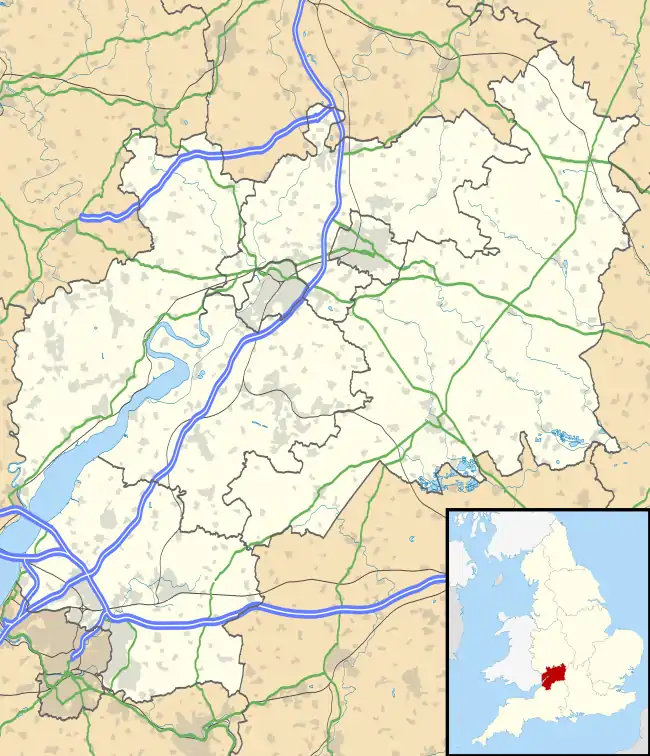The Playhouse, Cheltenham
Cheltenham Playhouse is a community theatre in Cheltenham, United Kingdom. It opened in 1945 as the Civic Playhouse and was run by the Corporation of Cheltenham; it was taken over by volunteers in 1958 who continue to run the operation as a registered charity. It is housed in the former Montpellier Baths and the building dates back to 1806/7, making it one of the two oldest surviving spa buildings in the town.
 | |
.jpg.webp) | |
 The Playhouse Location within Gloucestershire | |
| Coordinates | 51.896805°N 2.074265°W |
|---|---|
| Type | Theatre |
| Capacity | 186 |
| Opened | 1945 |
| Website | |
| www | |
History
In 1944, the Corporation of Cheltenham (now the borough council) realised the town’s lack of theatrical facilities and, spearheaded by town clerk Frank Littlewood, decided to open a Civic Playhouse to act as a home for local amateur companies. They decided to convert the swimming pool part of the Montpellier Baths complex and, despite war time restrictions on material and manpower, it opened on 9 April 1945,[1] making it, as far as is known, the only new theatre to commence operating during World War II. Good will messages and telegrams came from George Bernard Shaw and Ralph Richardson (who had been born in the town). The Corporation funded the services of the front of house staff, the cashier and box office facilities and all the publicity. A consultant producer and resident stage manager were also provided at the council's expense to assist the amateur groups, although the production requirements and expenses remained the responsibility of the societies. The first play performed was Arms and the Man by George Bernard Shaw.[2]
On 5 April 1950, the theatre suffered a major setback when the auditorium was severely damaged by fire.[3] The repair work was evidently undertaken with speed and the theatre was only closed for five months. However, the fire destroyed part of one of the theatre’s balconies (which were formerly viewing balconies for the swimming pool) and this was not restored until 2007.
When the Corporation decided it no longer wished to fund the theatre, volunteers formed the Theatre & Arts Club in 1956 and they officially took over the running of the venue in 1958 and over time acquired more part of the building which, at that time, were still being used as baths or for medical treatments.
In 2007, the theatre was flooded twice within the space of five weeks, along with many other parts of the UK. Only two performances had to be cancelled.[3]
In 2008, the auditorium and green room underwent a £340,000 refurbishment, half the funding of which came from Cheltenham Borough Council, together with additional donations from the Summerfield Charitable Trust,[4] Trefoil Trust, a generous bequest from a founder member, several of the resident non-professional companies and the charities own fundraising efforts.
Over recent years, the venue has expanded from being solely a venue for local amateurs to receiving small-scale professional theatre productions plus live music, cinema, comedy and dance. A professional Christmas production has been presented since 2010 and in 2019 this was financed by the theatre itself for the first time and future in-house professional productions are planned.
In 2019, planning permission was obtained for a major redevelopment of much of the complex (excluding the auditorium). Funding will be sought in the region of £3.5 million to achieve the charity's ambition to become a fully-staffed professional arts centre while still remaining home to local performers.[5]
Montpellier Baths
In 1716, the first Mineral springs were discovered in Cheltenham, transforming it into a spa. 1806/7 saw the opening of a small complex built by Henry Thompson that encompassed a handful of baths, a sudatory (steam room) and a self-administering enema machine. Around this time he also built Hygeia House to make use of three wells on its site for the taking of the waters but within a few years he turned this into his private house and in 1809 opened the Montpellier Spa for this purpose (which is now The Ivy restaurant). Water was pumped from around Thompson's land to the complex on this site so that in addition to the baths he could open a salts laboratory for the manufacturing of the Real Cheltenham Salts that could be added to water for bathing.[1][6]
The complex was enlarged circa 1818 when it boasted 14 warm baths, fitted with marble and Dutch tile, one large cold bath plus smaller ones and a boiler capable of heating up to 190°F.[7] Further enlargements followed in the 1830s and in the 1840s a large swimming pool was established; this was refurbished by the Corporation of Cheltenham when they bought the complex in 1899. The current auditorium is built over this pool and is used as a furniture store; it is shown each September as part of Heritage Open Days. In the Edwardian times in addition to slipper baths upstairs, the ground floor was used as a medicinal spa for a variety of treatments including a radio active mud bath.
Notes
- "The Playhouse Theatre". Visit Cheltenham. Archived from the original on 26 October 2019. Retrieved 20 July 2020.
- "About the company". The Playhouse Company. Archived from the original on 17 October 2016. Retrieved 20 July 2020.
- "A brief history of our building". Cheltenham Playhouse. Archived from the original on 13 June 2016. Retrieved 20 July 2020.
- "Grants paid 2008" (PDF). Summerfield Charitable Trust. Retrieved 20 July 2020.
- Flowers, Sophie (1 March 2019). "Huge new plans to transform historic Cheltenham theatre into modern performing arts hub". Gloucestershire Live. Archived from the original on 2 March 2019. Retrieved 20 July 2020.
- "The discovery of Cheltenham's spa waters". The History Press. Archived from the original on 25 September 2019. Retrieved 20 July 2020.
- "The Playhouse Cheltenham - A Brief History " Archived 24 April 2006 at the Wayback Machine